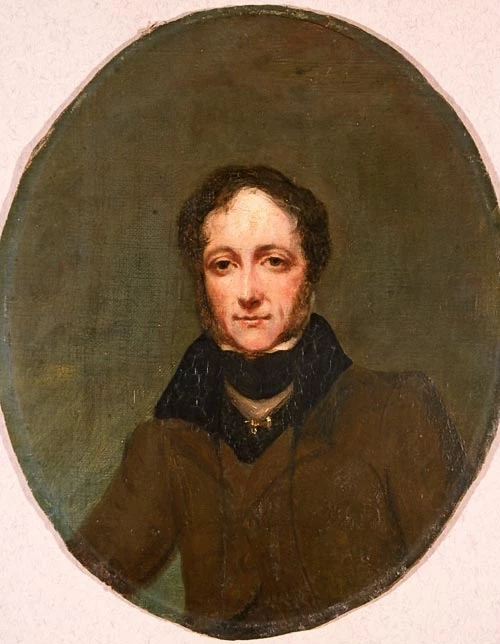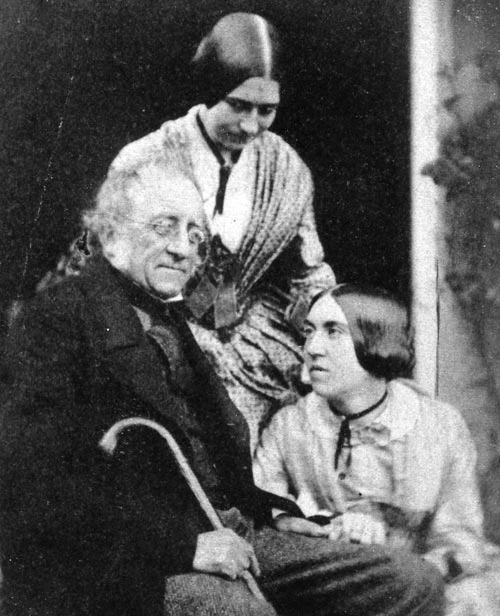The De la Beche archive at Amgueddfa Cymru
Sir Henry Thomas De la Beche (1796-1855)
The first geological map of Jamaica
- A more Ancient Dorset. A watercolour painted in 1830 by Henry De la Beche. This was the first portrayal of a fossil environment in its entirety, showing the interactions of the various elements of the fossil fauna and flora, in particular the large marine reptiles of the early Jurassic Period.
De la Beche and his daughters in Swansea, 1853
The Department of Geology at Amgueddfa Cymru houses one of the most important geological archives in the world. It contains over 2,000 items - letters, diaries, journals, sketches and photographs - of one of the leading geologists of the early 19th century, Sir Henry Thomas De la Beche (1796-1855).
During the first half of the 19th century De la Beche played an important role in the new science of geology. In addition to his own scientific contributions, he established geology as a profession and founded several of Britain's major geological institutions, including
- the British Geological Survey
- the Museum of Practical Geology (later the Geological Museum and now part of the Natural History Museum in London)
- the School of Mines (now part of Imperial College London)
- and the Mining Record Office (now part of the Coal Authority).
De la Beche was born in London and brought up in Devon and in Lyme Regis in Dorset, where he developed an interest in geology through his friendship with a local fossil collector, Mary Anning (1799-1847).
Jamaica
His family wealth came from slavery, and a sugar plantation in Jamaica, and in 1823-4 he spent 12 months on the estate. He toured the island, examining its rock outcrops. On his return to England he published the first description of the geology of Jamaica and its first geological map. De la Beche is regarded as the 'Father of Jamaican geology'.
De la Beche began mapping the rocks of Devon in the early 1830s. However unrest in Jamaica, related to the abolition of slavery and the collapse of the sugar market, left him in financial difficulties and unable to continue his work. He wrote to the Board of Ordnance offering to complete the geological mapping of Devon for the Government for £300. His application was successful and he was appointed Geologist to the Ordnance Trigonometrical Survey.
Founding the British Geological Survey
Once the Devon work was completed, he successfully applied to continue with the geological mapping of Cornwall, and in 1835 the Ordnance Geological Survey was established. From this grew today's British Geological Survey. When most geologists were clerics or interested amateurs of private means, De la Beche was one of the first professionals.
In 1837, De la Beche moved his Geological Survey to Swansea, recognising the economic importance of the Welsh coalfield. He soon became involved in the local scientific scene as a member of the Swansea Philosophical and Literary Institution and a friend of the Swansea naturalist Lewis Weston Dillwyn.
De la Beche was accompanied by his 18-year-old daughter Elizabeth (Bessie). She soon got to know one of Dillwyn's sons,
Lewis Llewelyn Dillwyn , and they married in August 1838. It is from their descendants that the Museum acquired the bulk of the De la Beche archive in the 1930s.Spectacular fossils discovered
The papers contain a wealth of information about the developing science of geology in the first half of the 19th century. The names of the geological timescale (Cambrian, Ordovician and so on) that we now take so much for granted were being proposed and argued over, new and spectacular fossils were being discovered and evidence of the Ice Age was being recognised for the first time.
De la Beche himself worked on the first descriptions of the large fossil marine reptiles, the ichthyosaurs and the plesiosaurs, and there is much in the papers on the formation of the Geological Survey and the other organizations he established.
Darwin writes to De la Beche
De la Beche corresponded with the leading geologists of the day and, with his experience of Jamaica, was often called on for advice relating to that island. One letter of 1842 in the collection quizzes him about the colours of horses, cattle and other animals bred for a number of generations on the island, and how they had changed. The author was Charles Darwin, at that time formulating his theory of evolution.
De la Beche was a skilled draughtsman and this is evident in the archive, for in addition to faithful landscape views, fossil illustrations and geological cross-sections, he sketched many caricatures and cartoons. Through these he would comment on developments in the science, or on his activities and those of his contemporaries.
The archive is an important resource for the history of geology and is frequently consulted by researchers from Britain and abroad - to arrange a visit, please
contact us .Editor's note: this article was amended on 28/06/17 to remove a reference to de la Beche being a "fair slave-owner".




Comments - (9)
Regards
Geoffrey
Hi Gary,
I’m afraid Duria Antiquior isn’t on display in the museum. It’s a rather fragile watercolour, and as such we restrict its exposure to light. We have it in secure storage in our archive section, but if you would like to visit it, that can probably be arranged.
Please let me know when you might like to come, and we’ll work out a suitable date.
Cindy
(Palaeontology Curator)
Is the Duria Antiquior on display and if so, where exactly is the museum?
Kind regards,
Gary
Hi there Anon,
I agree with you. The concept of 'fair' slave owners is outmoded and does not do enough to explain the complexity and devastation caused by the slave trade. I'm going to bring this up when the content team meets next to see what changes we can make to the article to acknowledge this. Thanks for bringing this to our attention.
Best wishes
Sara
Digital Team
Hi there Cedric,
Thanks for your comment - I'm glad you enjoyed this article and that it answered a question in a novel way!
All the best
Sara
Digital Team